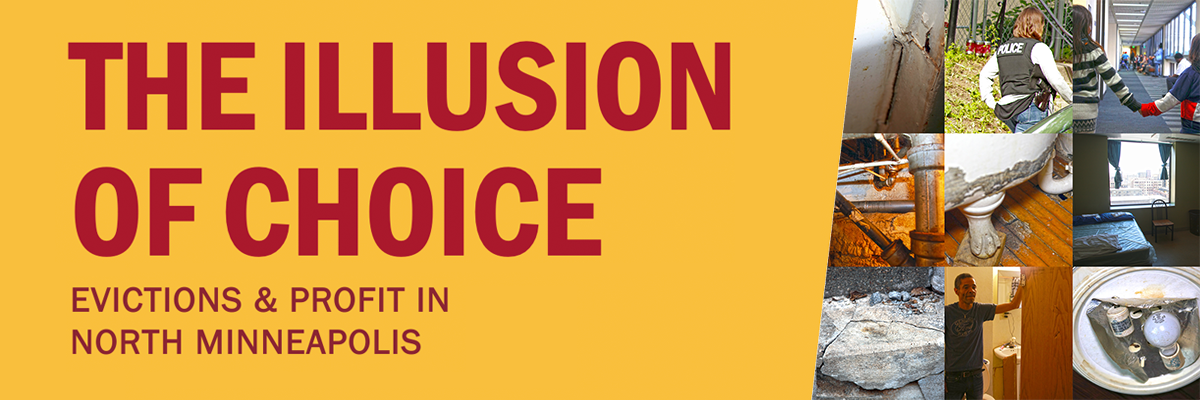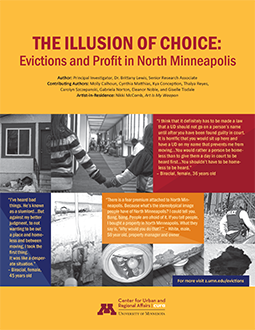
Stories of “The Illusion of Choice”
Author: Principal Investigator, Dr. Brittany Lewis, Senior Research Associate
Contributing Authors: Molly Calhoun, Cynthia Matthias, Kya Concepcion, Thalya Reyes, Carolyn Szczepanski, Gabriela Norton, Eleanor Noble, and Giselle Tisdale
Artist-in-Residence: Nikki McComb, Art Is My Weapon
Single Black mothers face the highest risk of eviction in the United States. Matthew Desmond’s 2016 book Evicted: Poverty and Profit in the American City brought this national crisis from the margins to the center of public discourse. From 2013-2015, approximately 50% of renter households in North Minneapolis experienced at least one eviction filing, a rate that is almost 25% higher than the 55402 zip code, which experienced the next highest rate of eviction filings in the city of Minneapolis. This disparity is particularly relevant given that these two zip codes contain just 8% of all rental units in the city. North Minneapolis is a community manufactured to contain undesirable populations through housing discrimination, decades of urban disinvestment, unfair lending practices, and disproportionate evictions; the situation has become further exacerbated by the rise in distressed-property investment. Single Black women with children living below the poverty line lead more than 60% of the Black households in North Minneapolis. As a result, 67% of residents are on some kind of county and federal government assistance, living one financial crisis away from losing their homes (Hartman and Robinson, 2003).
An eviction, also known as an unlawful detainer (UD), often elicits the vision of a sheriff knocking on a family’s door with a writ of eviction and a group of workers removing and placing a family’s belongings on the curb. In its narrowest form, an eviction can be described as the forced removal from someone’s home. In reality, evictions in the United States are much more complex. The threat of an eviction filing or repeated eviction filings have become tools in the landlord-tenant power dynamic, even when they do not result in a tenant vacating the home (Immergluck et al., 2019). In fact only 22% (15) of tenants interviewed had a writ of removal issued (i.e., the sheriff coming to forcibly remove the tenant from the home). A more holistic definition of an eviction filing includes “any involuntary move that is a consequence of a landlord-generated change or threat of change in the conditions of occupancy of a housing unit” (Hartman and Robinson, 2003, p. 466).
Key Takeaways from The Illusion of Choice Project
- When landlords make decisions that are driven by profit, the social impact including building housing stability for tenants becomes secondary.
- Choice is an illusion that is framed by limited and constrained options available to low-income, tenants of color in North Minneapolis and mediated by power brokers who can aid or disrupt opportunity at any point.
- City, county and state processes create critical pain points in the tenant-landlord relationship.
Select Project Impacts
- Collaborated with the Juxta Art Youth Participatory Action Research (YPAR) Team as they explored the inequities behind a differential social service system that tenants described as dehumanizing to create a simulation called the Social Service Runaround
- Partnered with KMOJ Radio Host Lissa Jones to create a three-part radio series on evictions in North Minneapolis.
- Filed an official declaration of fact to help inform and support the amicus curiae filed by Dorsey & Whitney, LLP on behalf of InquilinXs UnidXs por Justicia in support of Aaron Olson in the Central Housing Associates vs. Aaron Olson Minnesota Supreme Court case demystifying the realities of nonpayment of rent and the understudied realities of landlord retaliation.
CURA Policy Recommendations
- Policy Recommendation #1: Extending the Length of the Evictions Process
- Policy Recommendation #2: A Humane and Timely Approach to Emergency Assistance
- Policy Recommendation #3: Centering People’s Agency: Ending Current Self-Pay Procedures in Hennepin County Shelters
Evictions Report Table of Contents
- Introduction to Project
- Literature Review
- Methodology
- Findings: Landlords
- Findings: Tenants
- Findings: Social Service Run Around
- Research in Action: The Value and Impact of Actionable Research
- Policy Interventions from the Ground up: Producing Community-centered Public Policy and Programmatic Solutions
- References
- Acknowledgements and copyright information
